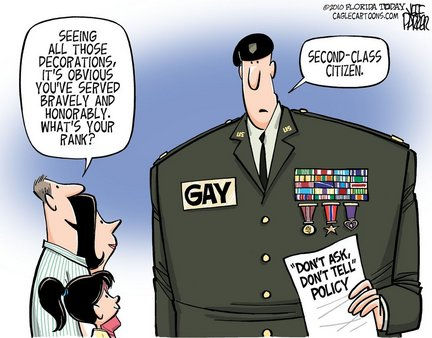Day 23 of Celebrating Pride: The “Don’t Ask, Don’t Tell” Policy-A Historical and Personal Perspective
- VaultBoyBrett
- Jun 23, 2024
- 6 min read

The “Don’t Ask, Don’t Tell” (DADT) policy was a significant chapter in the history of the U.S. military and the LGBTQIA+ community. Instituted during the Clinton administration, the policy was in effect from February 28, 1994, until September 20, 2011. This essay explores the history and impact of DADT, incorporating statistics and personal stories of those who lived through this era.
The Birth of DADT
The U.S. military did not officially exclude LGBTQIA+ service members from its ranks before the mid-20th century, but “homosexual acts” were grounds for discharge as far back as the Revolutionary War. In 1942, military regulations began listing homosexuality as an excludable characteristic for the first time.
In 1993, President Bill Clinton signed the policy known as “Don’t Ask, Don’t Tell” into law. It represented a compromise between those who wanted to end the longstanding ban on gays serving in the U.S. military and those who felt having openly gay troops would hurt morale and cause problems within military ranks. Under the new policy, gay, lesbian, and bisexual Americans could serve their country, as long as they kept their sexual identity under wraps.
The Impact of DADT
The DADT policy had a significant impact on queer identity in the military. It forced LGBTQ+ service personnel to conceal their sexual orientation, effectively preventing them from expressing their true selves. As a result of this suppression of identity, a culture of fear, secrecy, and discrimination arose.
An estimated 13,000 service members were discharged in the 17 years the policy was in effect. The policy led to all kinds of negative consequences, including wasted talent and money.
Personal Stories
Bridget Altenburg was in her junior year at West Point when President Bill Clinton signed the 1993 bill that became known as “Don’t Ask, Don’t Tell”. She was not yet serving in the military, nor had she come out as gay. But once she did, at age 24 while stationed in Germany, the law had real-life implications. She came out to some supportive friends in her unit, but then someone reacted negatively. “I immediately thought, ‘Oh, my God, what if she turns me in and that’s the end of my career?” she said. “The burden of ‘Don’t Ask, ‘Don’t Tell’ was much more dramatic than the burden of being gay.”
Joshua Gravett enlisted in the Army in 2003 and kept his sexuality a secret for eight years. He recalled the relief he felt just being able to put a photo of his partner on his desk at Fort Bragg, North Carolina, and bring a same-sex date to a military formal. “I could just be myself without risking the loss of my career that I had already put almost a decade into,” Gravett said.
The Repeal of DADT
Amid mounting opposition to “Don’t Ask, Don’t Tell,” President Barack Obama announced its repeal in mid-2011, ending 17 years of secrecy and silence for lesbian, gay, and bisexual members of the U.S. military. The repeal of DADT went into effect on September 20, 2011.
The Impact of the Repeal
The repeal of DADT was a significant milestone in the fight for LGBTQIA+ rights in the U.S. military. It allowed service members to serve openly, regardless of their sexual orientation, which was a major step towards equality and acceptance.
Positive Impacts
The repeal of DADT had several positive impacts. Firstly, it allowed LGBTQIA+ service members to serve openly and honestly, without fear of being discharged due to their sexual orientation. This openness fostered a more inclusive and accepting environment within the military.
Secondly, the repeal of DADT led to increased visibility of LGBTQIA+ individuals in the military, which helped to challenge stereotypes and promote understanding. This increased visibility also provided role models for younger LGBTQIA+ individuals considering a career in the military.
Finally, the repeal of DADT sent a powerful message that discrimination based on sexual orientation was no longer acceptable in the U.S. military. This set a precedent for other institutions and organizations, both within the U.S. and internationally.
Challenges and Ongoing Issues
Despite the positive impacts of the repeal, challenges and issues remain. Some LGBTQ+ service members have reported experiencing ongoing discrimination and harassment, suggesting that changing policy is not the same as changing culture. Furthermore, the repeal of DADT did not initially extend to transgender service members, who were not allowed to serve openly until 2016. Even then, transgender service members have faced ongoing challenges and policy reversals.
Transgender Military Ban History
The history of transgender individuals serving in the U.S. military has been marked by changing policies and ongoing debates. The U.S. military officially banned transgender individuals from serving starting from at least 1960, possibly earlier, under Executive Order 10450.
In 2016, the ban was lifted, allowing transgender
individuals to serve in their identified or assigned gender upon completing their transition. However, this policy was short-lived. In 2017, President Trump announced on Twitter that the country would no longer “accept or allow” transgender Americans to serve in the military, citing "tremendous medical costs and disruption". This ban took effect in April 2019. Transgender personnel who were already serving were allowed to continue, but recruits were locked out.
On January 25, 2021, President Biden overturned the ban, allowing transgender individuals to serve openly in the military. As of now, there are no restrictions on military service by transgender individuals.
The Future of “Don’t Ask, Don’t Tell”
While the “Don’t Ask, Don’t Tell” policy has been repealed, it’s important to note that policy changes are often influenced by the political climate, which can shift with each election cycle. The repeal of DADT was a significant step forward, but it doesn’t guarantee that similar policies won’t be implemented in the future.
The potential for such policies to return in other forms depends on a variety of factors, including the views of future administrations, the composition of Congress, and public opinion. It’s also worth noting that while DADT has been repealed at the federal level, discrimination against LGBTQIA+ individuals still exists in many forms and contexts, both within and outside the military.
Preventing the Return of Discriminatory Policies: A Multifaceted Approach
Advocacy and Education
One of the most effective ways to prevent the return of such policies is through advocacy and education. This involves raising awareness about the harmful effects of such policies and promoting understanding and acceptance of LGBTQIA+ individuals. Advocacy can take many forms, from grassroots activism to lobbying for legislative change.
Legislation
Legislation plays a crucial role in preventing the return of discriminatory policies. Laws that explicitly protect LGBTQIA+ individuals from discrimination can help ensure that policies like DADT are not reintroduced. For example, the Equality Act, if passed, would provide comprehensive protections for LGBTQIA+ individuals across key areas of life, including employment, housing, and public spaces.
Institutional Policies
Institutions, including the military, can implement their own policies to protect LGBTQIA+ individuals. These policies can include explicit protections for LGBTQIA+ individuals, training programs to promote understanding and acceptance, and mechanisms for reporting and addressing discrimination.
Public Opinion
Public opinion can have a significant impact on policy. As societal attitudes towards LGBTQIA+ individuals continue to evolve, it becomes less likely that discriminatory policies will be reintroduced. Therefore, efforts to shift public opinion through education and awareness campaigns can be an effective strategy.
International Pressure
International norms and pressure can also play a role in preventing the return of discriminatory policies. Many countries look to international human rights standards as a guide, and pressure from the international community can influence national policies.
In conclusion, the “Don’t Ask, Don’t Tell” policy was a significant chapter in the history of LGBTQIA+ rights in the U.S. military. Its repeal marked a milestone, but it doesn’t guarantee that similar policies won’t return in the future. The potential for such policies depends on various factors, including future administrations, Congress, and public opinion.
However, through advocacy, legislation, institutional policies, shifts in public opinion, and international pressure, we can work towards preventing the return of such policies. It’s a continuous effort that requires everyone’s participation. As we reflect on the history of DADT, let’s strive for a future where all individuals can serve their country openly and without fear of discrimination.
Extras:
Documentaries:
“Serving in Secret: Love, Country, and Don’t Ask, Don’t Tell” is a documentary in MSNBC’s “Turning Point” series, which traces the history of LGBTQIA+ military service and the discrimination that’s plagued it since the beginning.
“The Strange History of Don’t Ask, Don’t Tell” provides a detailed account of the DADT policy.
Movies:
“The Inspection” is a drama that explores the experiences of a young, gay Black man who decides to join the Marines.
“A Marine Story” is a crime drama that depicts the struggles of a lesbian Marine officer who must conceal her sexuality under DADT.
Videos:
Books:
“Major Conflict: One Gay Man’s Life in the Don’t-Ask-Dont-Tell Military” by Jeffrey McGowan Maj USA provides a detailed account of the efforts to repeal DADT.
“Don’t Ask, Don’t Tell: Debating the Gay Ban in the Military” by Aaron Belkin and Geoffrey Bateman explores the critical aspects of the gays-in-the-military issue.
“Don’t Ask, Don’t Tell” by M. T. Pope, Tina Brooks McKinney, Brenda Hampton, and Terry E. Hill explores the experiences of LGBTQ service members under DADT.
Audiobooks:
“Don’t Ask Don’t Tell: Don’t Ask, Don’t Tell, Book 1” by Miski Harris is available as an audiobook.
“Don’t Ask, Don’t Tell” by Terry E. Hill, M. T. Pope, Tina Brooks Mckinney, Brenda Hampton is also available as an audiobook.
Please note that availability may vary depending on your location and the platform you use. I hope these resources help you gain a deeper understanding of the “Don’t Ask, Don’t Tell” policy and its impact on the LGBTQIA+ community.
Sources:




















Comments